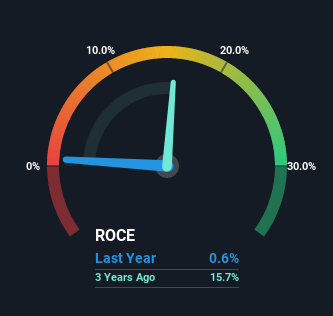- Brazil
- /
- Specialty Stores
- /
- BOVESPA:AMAR3
Marisa Lojas' (BVMF:AMAR3) Returns On Capital Not Reflecting Well On The Business

When it comes to investing, there are some useful financial metrics that can warn us when a business is potentially in trouble. More often than not, we'll see a declining return on capital employed (ROCE) and a declining amount of capital employed. This combination can tell you that not only is the company investing less, it's earning less on what it does invest. And from a first read, things don't look too good at Marisa Lojas (BVMF:AMAR3), so let's see why.
Return On Capital Employed (ROCE): What is it?
If you haven't worked with ROCE before, it measures the 'return' (pre-tax profit) a company generates from capital employed in its business. To calculate this metric for Marisa Lojas, this is the formula:
Return on Capital Employed = Earnings Before Interest and Tax (EBIT) ÷ (Total Assets - Current Liabilities)
0.006 = R$13m ÷ (R$3.3b - R$1.3b) (Based on the trailing twelve months to March 2022).
So, Marisa Lojas has an ROCE of 0.6%. In absolute terms, that's a low return and it also under-performs the Multiline Retail industry average of 8.0%.
Check out our latest analysis for Marisa Lojas

In the above chart we have measured Marisa Lojas' prior ROCE against its prior performance, but the future is arguably more important. If you'd like, you can check out the forecasts from the analysts covering Marisa Lojas here for free.
The Trend Of ROCE
There is reason to be cautious about Marisa Lojas, given the returns are trending downwards. To be more specific, the ROCE was 1.5% five years ago, but since then it has dropped noticeably. On top of that, it's worth noting that the amount of capital employed within the business has remained relatively steady. This combination can be indicative of a mature business that still has areas to deploy capital, but the returns received aren't as high due potentially to new competition or smaller margins. So because these trends aren't typically conducive to creating a multi-bagger, we wouldn't hold our breath on Marisa Lojas becoming one if things continue as they have.
In Conclusion...
In summary, it's unfortunate that Marisa Lojas is generating lower returns from the same amount of capital. Long term shareholders who've owned the stock over the last five years have experienced a 65% depreciation in their investment, so it appears the market might not like these trends either. That being the case, unless the underlying trends revert to a more positive trajectory, we'd consider looking elsewhere.
If you'd like to know about the risks facing Marisa Lojas, we've discovered 3 warning signs that you should be aware of.
If you want to search for solid companies with great earnings, check out this free list of companies with good balance sheets and impressive returns on equity.
New: Manage All Your Stock Portfolios in One Place
We've created the ultimate portfolio companion for stock investors, and it's free.
• Connect an unlimited number of Portfolios and see your total in one currency
• Be alerted to new Warning Signs or Risks via email or mobile
• Track the Fair Value of your stocks
Have feedback on this article? Concerned about the content? Get in touch with us directly. Alternatively, email editorial-team (at) simplywallst.com.
This article by Simply Wall St is general in nature. We provide commentary based on historical data and analyst forecasts only using an unbiased methodology and our articles are not intended to be financial advice. It does not constitute a recommendation to buy or sell any stock, and does not take account of your objectives, or your financial situation. We aim to bring you long-term focused analysis driven by fundamental data. Note that our analysis may not factor in the latest price-sensitive company announcements or qualitative material. Simply Wall St has no position in any stocks mentioned.
About BOVESPA:AMAR3
Slight with imperfect balance sheet.
Similar Companies
Market Insights
Community Narratives



